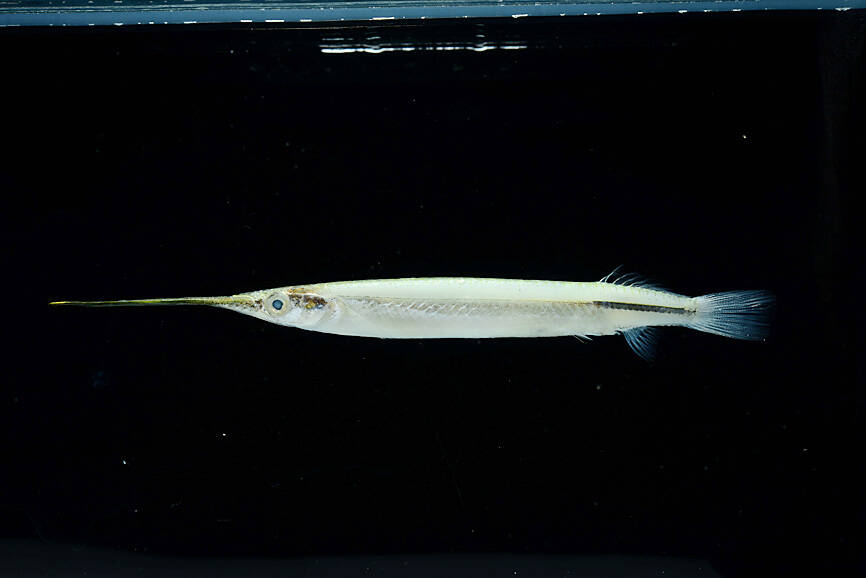A previously unidentified fish species has been named, and its origin has been traced to southern Taiwan following joint efforts between Taiwanese researchers and those at the Museum der Natur Hamburg in Germany.
The fish, which had been on display in the museum since 1907, was labeled “Takao, Formosa,” referring to Kaohsiung’s name during the Japanese colonial rule, University of Taipei Department of Earth and Life Science associate professor Liao Yun-chih (廖運志) said on Saturday.
A research team led by Chang Chih-wei (張至維) from the National Academy of Marine Research in 2023 worked with Ralf Thiel and other researchers from the museum, sampling and comparing different fish species to learn more about the species’ taxonomy, he said.

Photo courtesy of Liao Yun-chih
The researchers eventually learned that the fish was a previously unidentified species of estuary garfish, and it was named Zenarchopterus takaoensis, he said, adding that the researchers’ findings were published last year by peer-reviewed journal Zootaxa.
Liao thanked the Hamburg museum for providing specimen measurements and X-ray images, and for sending specimens to Taiwan so that he and Chang could examine and compare them in more detail.
The process highlighted the importance of museum specimen collections to scientific research, he said.
The fish, given the common name “Takao,” has a distinct needle-shaped lower jaw protruding from the front of its body like other garfish. Due to this prominent characteristic, garfish are commonly known as needlefish or sea needles, he said.
“It is a viviparous fish, meaning the male fish fertilizes the egg inside the female fish’s body. The embryo develops directly in the body, and the young fish can swim independently after birth,” he said.
“There are 19 known species of garfish in the world. Taiwan originally only recorded two species, but recent findings have shown four species indigenous to Taiwan,” he said.
American researcher Bruce Collette first noticed the Takao at the Hamburg museum in 1986, but was unable to identify its taxonomy at the time, he said.
“Subsequent research also failed to produce findings on the fish, as specimens were hard to collect, and the mangroves where the Takao was once distributed disappeared due to the Kaohsiung Port expansion project,” he said.
The research team set out in 2021 to gather specimens of the fish, but found they could not use nets due to the fish’s slender body. They later discovered that shreds of cod could be used as bait to catch the fish on a line, he said.
“In 2023, we finally caught seven of the fish in the mangroves near Dongshi Fishing Harbor in Chiayi County,” he said.
“We took tissue samples and conducted molecular identification, then compared the samples of similar fish species in Okinawa, Japan, and southwestern Taiwan, confirming that it was an unrecorded species.”
However, due to its small number, further research is needed to detail the fish’s distribution, he said.

Taiwan is to commence mass production of the Tien Kung (天弓, “Sky Bow”) III, IV and V missiles by the second quarter of this year if the legislature approves the government’s NT$1.25 trillion (US$39.78 billion) special defense budget, an official said yesterday. Commenting on condition of anonymity, a defense official with knowledge of the matter said that the advanced systems are expected to provide crucial capabilities against ballistic and cruise missiles for the proposed “T-Dome,” an advanced, multi-layered air defense network. The Tien Kung III is an air defense missile with a maximum interception altitude of 35km. The Tien Kung IV and V

The disruption of 941 flights in and out of Taiwan due to China’s large-scale military exercises was no accident, but rather the result of a “quasi-blockade” used to simulate creating the air and sea routes needed for an amphibious landing, a military expert said. The disruptions occurred on Tuesday and lasted about 10 hours as China conducted live-fire drills in the Taiwan Strait. The Civil Aviation Administration (CAA) said the exercises affected 857 international flights and 84 domestic flights, affecting more than 100,000 travelers. Su Tzu-yun (蘇紫雲), a research fellow at the government-sponsored Institute for National Defense and Security Research, said the air

A strong continental cold air mass is to bring pollutants to Taiwan from tomorrow, the Ministry of Environment said today, as it issued an “orange” air quality alert for most of the country. All of Taiwan except for Hualien and Taitung counties is to be under an “orange” air quality alert tomorrow, indicating air quality that is unhealthy for sensitive groups. In China, areas from Shandong to Shanghai have been enveloped in haze since Saturday, the ministry said in a news release. Yesterday, hourly concentrations of PM2.5 in these areas ranged from 65 to 160 micrograms per cubic meter (mg/m³), and pollutants were

Taiwan’s armed forces have established response protocols for a wide range of sudden contingencies, including the “Wan Chun Plan” to protect the head of state, the Ministry of Defense (MND) said today. After US President Donald Trump on Saturday launched a series of airstrikes in Venezuela and kidnapped Venezuelan President Nicolas Maduro, concerns have been raised as to whether China would launch a similar “decapitation strike” on Taiwan. The armed forces regularly coordinate with relevant agencies and practice drills to ensure preparedness for a wide range of scenarios, Vice Minister of National Defense Hsu Szu-chien (徐斯儉) told reporters before a